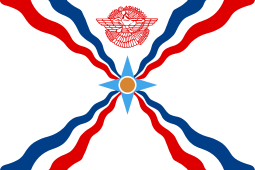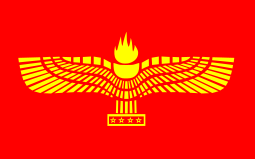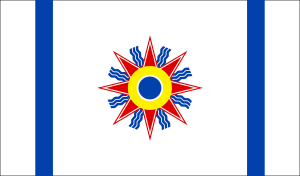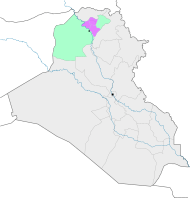Alqosh
Alqosh (Syriac: ܐܲܠܩܘܿܫ,[2][3][4] Judeo-Aramaic: אלקוש, Arabic: ألقوش,[1] alternatively spelled Alkosh or Alqush) is an ethnic Assyrian[5][6] town in northern Iraq and is within Nineveh Plains. It is a sub-district of the Tel Kaif District and is 45 km north of Mosul. The town has a military base that belongs to the Nineveh Plain Protection Units.[7][8][9] Colonel R. S. Stafford, who was the British Administrative Inspector for Mosul, referred to Alqosh as an "Assyrian center" where another massacre (in reference to the Simele massacre) was planned.[10]
Alqosh ܐܲܠܩܘܿܫ ألقوش[1] | |
|---|---|
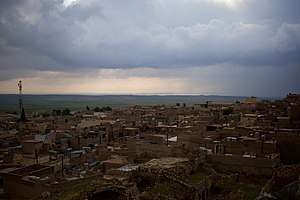 Sunset over a stormy Alqosh | |
 Alqosh | |
| Coordinates: 36°43′55.6″N 43°5′42.6″E | |
| Country | |
| Governorate | Ninawa |
| District | Tel Kaif (officially) |
| Founded | 1500 BC |
| Time zone | GMT +3 |
| • Summer (DST) | GMT +4 |
In 2014 the mayor of Aqlosh, Faiz Jahwareh, was illegally detained and replaced by KDP member Lara Zara, only to be reinstated after protests by Alqosh residents.[11] Jahwareh was again detained and replaced by the KRG in July 2017 on the basis of false corruption charges that were dismissed by the Iraqi Federal Court.[12][13] Basim Bello, mayor of nearby Tel Keppe, was also unlawfully removed by the same parties in August 2017, and reinstated by order of the Governor of Nineveh in August 2018.[14][15]
Christianity and Alqosh
Since its establishment, Alqosh was a place for worship. either for the Sumerian/Assyrian god Sīn, who was also worshiped at Ur as the Sumerian equivalent Nanna, or for the god El-Qustu.
Alqosh became an important town for the Church of the East Christianity after the Assyrian monk Hirmiz carved out a monastery of the mountains of Alqosh. This abbey is called "Rabban Hormizd Monastery" and was crafted in 640 AD at the outskirts of the Mountains of Alqosh. It was used as the Seat for many patriarchs of the Church of the East. From this monastery came Yohannan Sulaqa, who decided to unite with the Catholic Church in 1553 AD and established the Church of Assyria and Mosul, which by the 18th century had become renamed the Chaldean Catholic Church by Rome.
Before that, all of the inhabitants of Alqosh, like their brothers in other Assyrian towns, followed what is erroneously called the Nestorian faith, but actuality were a part of the Church of the East. From 1610 to 1617, the Patriarchate of Alqosh, under Mar Eliyya VIII, entered in Full Communion with Rome. the union was reinstated later in 1771 when the patriarch Eliya Denkha signed a Catholic confession of faith, although no formal union resulted till the reign of patriarch Yohannan VIII (Eliya) Hormizd (1760–1838).[16]
Prophet Nahum and Alqosh
The ancient synagogue in Alqosh reportedly contains the tomb of the prophet Nahum, who correctly predicted the end of the Assyrian Empire. Nahum's bones have been relocated to a nearby church. It was common for Iraqi Jews to make a pilgrimage to Alqosh during Shavuot. "He who has not made the pilgrimage to Nahum’s tomb has not yet known real pleasure", was a common saying.[17] After the most of the Jews emigrated to Israel in 1951, the tomb of Nahum was left to a Chaldean family to look after.[18]
Destruction
Other attacks
- The village was attacked and sacked by Timur (Tamerlane) in 1401 AD.[19]
- Alqosh was attacked in 1508 AD by Pasha of Baghdad Bar Yak (Murad Bey).[19]
- Soran Kurds attacked Alqosh, killing nearly 300 villagers in 1831.[20]
- Mosa Pasha, the governor of Amadiya, approached Alqosh and put fire to Rabban Hermizd Monastery in 1828 AD.[21]
- Mohammed Pasha (Mira Koor), the Kurdish prince of Rowanduz attacked Alqosh, killing over 600 of its inhabitants in 1832 AD.[21]
- Resoul Beck, Mira Koor's brother, repeated the attack in 1840 AD.[21]
- Rabban Hormizd Monastery was attacked by the Kurds, and 1000 manuscripts may have been destroyed.[20]
- In 2014, the terrorists associated with the radical Islamic State of Iraq and the Levant (ISIL) came close to Alqosh. Almost all of the people fled Alqosh; however, many men and youths did not leave Alqosh due to a desire to protect their town. ISIL failed to take the town after protection from the Assyrian militia[22] Alqoshians and Kurdish Peshmerga fighters.[23]
Demographics
The town of Alqosh is primarily home to Assyrians but has a smaller percentage of Yazidi inhabitants.[24] In 1913, the town of Alqosh, was according to Tfinkdji inhabited by 7,000 Chaldean Catholic Assyrians.[6] Many have immigrated outside of the country in huge numbers since the 1970s. It is estimated that at least 40,000 "Alqushnaye" immigrants and their 2nd and 3rd generations now live in the cities of Detroit, Michigan, the western suburb of Fairfield in Sydney, Australia and San Diego, California.
In February 2010, the attacks against Assyrians in Mosul forced 4,300 Assyrians to flee from Mosul to the Nineveh plains where there is an Assyrian majority population. A report by the United Nations stated that 504 Assyrians at once migrated to Alqosh. Many Assyrians from Mosul and Baghdad since the post-2003 Iraq war have fled to Alqosh for safety. The town's population in 2020 is estimated to be roughly 4,600.[25]
Climate
Alqosh has a semi-arid climate (BSh) with extremely hot and dry summers, and cool wet winters.
| Climate data for Alqosh | |||||||||||||
|---|---|---|---|---|---|---|---|---|---|---|---|---|---|
| Month | Jan | Feb | Mar | Apr | May | Jun | Jul | Aug | Sep | Oct | Nov | Dec | Year |
| Average high °C (°F) | 12 (54) |
14 (57) |
20 (68) |
26 (79) |
34 (93) |
38 (100) |
43 (109) |
40 (104) |
38 (100) |
30 (86) |
20 (68) |
14 (57) |
27 (81) |
| Average low °C (°F) | 2 (36) |
4 (39) |
8 (46) |
11 (52) |
16 (61) |
21 (70) |
25 (77) |
24 (75) |
20 (68) |
14 (57) |
6 (43) |
4 (39) |
13 (55) |
| Average precipitation mm (inches) | 39 (1.5) |
69 (2.7) |
51 (2.0) |
27 (1.1) |
0 (0) |
0 (0) |
0 (0) |
0 (0) |
0 (0) |
6 (0.2) |
36 (1.4) |
60 (2.4) |
288 (11.3) |
| Average precipitation days | 10 | 10 | 11 | 9 | 0 | 0 | 0 | 0 | 0 | 5 | 8 | 12 | 65 |
| Source: World Weather Online (2000-2012)[26] | |||||||||||||
See also
References
- معاناة الكورد الايزديين في ظل الحكومات العراقية، 1921-2003. University of California, Berkeley, USA. 2008.
- Maclean, Arthur John (1901). Dictionary of the Dialects of Vernacular Syriac. Oxford: Clarendon Press. p. 13b.
- Payne Smith, Robert (1879–1901). Thesaurus Syriacus (in Latin). Oxford: Clarendon Press. 221.
- Thomas A. Carlson, “Alqosh — ܐܠܩܘܫ ” in The Syriac Gazetteer last modified June 7, 2014, http://syriaca.org/place/19.
- Ronald Sempill Stafford (1935). The Tragedy of the Assyrian Minority in Iraq. p. 187.
- Donabed, Sargon (1 March 2015). Reforging a Forgotten History. Edinburgh University Press. doi:10.3366/edinburgh/9780748686025.001.0001. ISBN 978-0-7486-8602-5.
- "Ny bas stärker NPU:s grepp om Nineveslätten". hujada.com. Retrieved 23 May 2020.
- "Militias of Iraqi Christians resist Islamic State amid sectarian strife". Catholic Philly. Retrieved 23 May 2020.
- Kruczek, Gregory J. (13 December 2018). "Christian Minorities and the Struggle for Nineveh: The Assyrian Democratic Movement in Iraq and the Nineveh Plains Protection Units" (PDF). VTechWorks: 29.
- Zubaida, Sami (2000). "Contested Nations: Iraq and the Assyrians". Nations and Nationalism. 6 (3): 363–382. doi:10.1111/j.1354-5078.2000.00363.x. ISSN 1354-5078.
- "Iraqi Christians reject second mayor installed by pro-Kurd council". World Watch Monitor. Retrieved 23 May 2020.
- "Post - Assyrian Policy Institute". assyrianpolicy. Retrieved 12 July 2019.
- "Iraqi Christians reject second mayor installed by pro-Kurd council". World Watch Monitor. Retrieved 12 July 2019.
- "Mayor of Tel Keppe Reinstated After Unlawful Dismissal by KDP". Assyrian Policy Institute. 8 August 2018. Retrieved 16 June 2019.
- "Alqosh, Christian village on faultline of Iraq and Kurdistan". Middle East Eye. 22 September 2017. Retrieved 28 March 2019.
- Frazee, Charles A. (2006). Catholics and Sultans: The Church and the Ottoman Empire 1453–1923. Cambridge University Press. p. 210. ISBN 978-0-521-02700-7.
- Neurink, Judit (5 July 2015). "Kurdistan needs help to preserve its Jewish heritage". The Jerusalem Post. Retrieved 6 July 2015.
- JTA. "Historic Jewish site outside Mosul said at risk of collapse". www.timesofisrael.com. Retrieved 23 May 2020.
- David Wilmshurst (2000). The Ecclesiastical Organisation of the Church of the East, 1318-1913 (582 ed.). Peeters Publishers. ISBN 9042908769.
- Wilmhurst, David (2000). The Ecclesiastical Organization of the Church of the East, 1318-1913. p. 205.
- Geoff Hann, Karen Dabrowska, Tina Townsend-Greaves (2015). Iraq: The ancient sites and Iraqi Kurdistan. ISBN 1841624888.CS1 maint: multiple names: authors list (link)
- Foundation, Thomson Reuters. "Iraq's traumatised minorities: test of unity after Mosul offensive". news.trust.org. Retrieved 24 May 2020.
- Costa-Roberts, Daniel (15 March 2015). "8 things you didn't know about Assyrian Christians". PBS. Retrieved 6 July 2015.
- "UNPO: Assyria: Crowds Gather to Protest Mayor's Unfounded Expulsion". unpo.org. Retrieved 24 May 2020.
- "Population Project". Shlama Foundation. Retrieved 24 May 2020.
- "Alqosh, Ninawa Monthly Climate Average, Iraq". World Weather Online. Retrieved 22 January 2017.
Sources
- Frazee, Charles A. (2006) [1983]. Catholics and Sultans: The Church and the Ottoman Empire 1453-1923. Cambridge: Cambridge University Press.CS1 maint: ref=harv (link)
- Addai Scher, Notice sur les manuscrits syriaques conservés dans la bibliothèque du couvent des Chaldéens de Notre-Dame-des-Semences, Journal Asiatique Sér. 10: 8, 9 (1906). This may be found online at Gallica by searching for "Journal Asiatique". An English translation of the first portion is at tertullian.org
